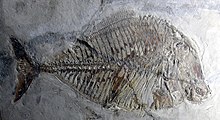Pycnodus
| Pycnodus Temporal range: [1]
| |
|---|---|

| |
| Pycnodus platessus | |
| Scientific classification | |
| Kingdom: | Animalia |
| Phylum: | Chordata |
| Class: | Actinopterygii |
| Order: | †Pycnodontiformes |
| Family: | †Pycnodontidae |
| Genus: | †Pycnodus Agassiz, 1833 |
Pycnodus (from Greek: πυκνός puknós, 'dense' and Greek: ὀδούς odoús 'tooth') is an extinct genus of ray-finned fish ranging from the Jurassic to Eocene periods. As its name suggests, it is the type genus of Pycnodontiformes.

The known whole fossils of Pycnodus are around 12 centimetres (5 in) long, and have a superficial resemblance to angelfish or butterflyfish. The animals, as typical of all other pycnodontids, had many knob-like teeth, forming pavements in the jaws with which to break and crush hard food substances, probably mollusks and echinoderms. These teeth are the most common form of fossil.
Pycnodus fossils have been found in present-day India, Northern Africa, Belgium, England, and Italy, regions corresponding with the Tethys Ocean.[2] A specimen of the prehistoric whale, Basilosaurus isis, was found in the Eocene-aged Wadi El Hitan with stomach contents of its last meals, including a large specimen of the species P. mokattamensis along with skeletons of a smaller whale called Dorudon.[3]
References[]
- ^ "†Pycnodus Agassiz 1835 (ray-finned fish)". PBDB.
- ^ Mohabey, D. M.; Udhoji, S. G. (May 1996). "Pycnodus lametae (Pycnodontidae), a Holostean Fish from Freshwater Upper Cretaceous Lameta Formation of Maharashtra". Geological Society of India. 47 (5): 593–598.
- ^ Voss, Manja; Antar, Mohammed Sameh M.; Zalmout, Iyad S.; Gingerich, Philip D. (2019). "Stomach contents of the archaeocete Basilosaurus isis: Apex predator in oceans of the late Eocene". PLOS ONE. 14 (1): e0209021. Bibcode:2019PLoSO..1409021V. doi:10.1371/journal.pone.0209021. PMC 6326415. PMID 30625131.
- Pycnodontiformes genera
- Middle Jurassic bony fish
- Late Jurassic bony fish
- Cretaceous bony fish
- Paleocene fish
- Eocene fish
- Bathonian genus first appearances
- Lutetian genus extinctions
- Cretaceous fish of Europe
- Paleogene fish of Europe
- Taxa named by Louis Agassiz
- Prehistoric ray-finned fish stubs
